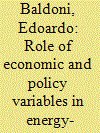|
|
|
Sort Order |
|
|
|
Items / Page
|
|
|
|
|
|
|
| Srl | Item |
| 1 |
ID:
088489


|
|
|
|
|
| Publication |
2009.
|
| Summary/Abstract |
fixed exchange rate arrangement in place from 1998 to 2005. The results obtained from Granger causality tests in a vector autoregression framework indicate that: (i) China actually conducted independent monetary policy during the fixed exchange rate period; and (ii) market-oriented policy measures are impotent in influencing real output and prices. The framework of the investigation into the autonomy of monetary policy adapts to the Chinese economic condition that primary loan and deposit rates are set by the central bank. Based on the empirical results, the present paper provides alternative strategies to improve the effectiveness of monetary policy in China, including developing the financial system and solidifying microeconomic fundamentals instead of forcing the adaptation of a more flexible exchange rate regime.
|
|
|
|
|
|
|
|
|
|
|
|
|
|
|
|
| 2 |
ID:
106024


|
|
|
|
|
| Publication |
2011.
|
| Summary/Abstract |
This article devises a method to separate the Global Terrorism Database (GTD) into transnational and domestic terrorist incidents. This decomposition is essential for the understanding of some terrorism phenomena when the two types of terrorism are hypothesized to have different impacts. For example, transnational terrorism may have a greater adverse effect than domestic terrorism on economic growth. Moreover, the causes of the two types of terrorism may differ. Once the data are separated, we apply a calibration method to address some issues with GTD data - namely, the missing data for 1993 and different coding procedures used before 1998. In particular, we calibrate the GTD transnational terrorist incidents to ITERATE transnational terrorist incidents to address GTD's undercounting of incidents in much of the 1970s and its overcounting of incidents in much of the 1990s. Given our assumption that analogous errors characterize domestic terrorist events in GTD, we apply the same calibrations to adjust GTD domestic incidents. The second part of the article investigates the dynamic aspects of GTD domestic and transnational terrorist incidents, based on the calibrated data. Contemporaneous and lagged cross-correlations for the two types of terrorist incidents are computed for component time series involving casualties, deaths, assassinations, bombings, and armed attacks. We find a large cross-correlation between domestic and transnational terrorist incidents that persists over a number of periods. A key finding is that shocks to domestic terrorism result in persistent effects on transnational terrorism; however, the reverse is not true. This finding suggests that domestic terrorism can spill over to transnational terrorism, so that prime-target countries cannot ignore domestic terrorism abroad and may need to assist in curbing this homegrown terrorism.
|
|
|
|
|
|
|
|
|
|
|
|
|
|
|
|
| 3 |
ID:
124547


|
|
|
|
|
| Publication |
2013.
|
| Summary/Abstract |
Recent literature has advanced the view that the Gibson paradox, or the positive correlation of the price level with nominal interest rates, is nearly always a gold standard phenomenon. We argue that the Gibson correlation is more accurately classified as a statistical artifact of commodity money systems, with the gold standard merely representing one such system. Using new evidence from Chinese monetary history, this article gives evidence that the Gibson paradox appeared during China's silver-cored metallic standard era. Estimates obtained from recursive ordinary least squares specifications and vector auto-regressions performed, using the Shanghai Yinchai Rate and the Chinese Wholesale Price Index, confirm a Gibson correlation for China during the period 1873-1924.
|
|
|
|
|
|
|
|
|
|
|
|
|
|
|
|
| 4 |
ID:
152805


|
|
|
|
|
| Summary/Abstract |
This study examines the impact of monetary policy shocks on output, prices and interest rates in Sri Lanka during the period 2003–2012. It finds a strong transmission of policy rate shocks onto the money market rates and the government securities market yields. However, banking sector interest rates exhibit a smaller and slower impact compared to money and government securities market rates. The study also finds a weak policy interest rate transmission onto the real sector and prices. The direction of relationships between variables and policy shocks is in conformity with the existing theoretical and empirical priors. The existence of a large informal economy, volatile excess market liquidity, shallowness of financial markets, relatively less flexible interest rates on deposit and loan products, and fiscal accommodation by monetary policy at times are identified as reasons for weak transmission.
|
|
|
|
|
|
|
|
|
|
|
|
|
|
|
|
| 5 |
ID:
166555


|
|
|
|
|
| Summary/Abstract |
Energy saving is a major policy objective worldwide and in the EU in particular. Evaluating the convenience of energy-efficient investments, however, is complex. This paper aims to apply stochastic Life Cycle Costing to assess the economic value of energy-efficient building retrofitting investments. The proposed approach investigates how macroeconomic variables affect such an evaluation by explicitly taking into account their interdependent stochastic nature. Consequently, the economic evaluation of an investment is itself stochastic thus expressing both its expected value and its inherent uncertainty and risk. On this basis, an illustrative case-study is presented, where alternative designs of the energy-saving intervention are compared and a sensitivity analysis performed to identify the determinants of the LCC outcome and of its variability. In terms of policy implications, a tool providing a sounder evaluation of the convenience of such investments can suggest when and to what extent incentives may be appropriate to facilitate these investments and what possible financial instruments could be put forward in order to reduce the associated risk.
|
|
|
|
|
|
|
|
|
|
|
|
|
|
|
|
| 6 |
ID:
173201


|
|
|
|
|
| Summary/Abstract |
We verify the potential impact of credit-enhanced monetary policy rule on inflation, GDP and credit dynamics in Turkey (2002Q1—2018Q3), where the Turkish Cental Bank takes into account financial stability in its inflation-targeting strategy. We estimate interest rates from two monetary policy rules (classic and augmented with the exogenous credit-to-GDP gap) with time-varying parameters (TVP) and assess their performance in a TVP-VAR model. The results show that after the global crisis both observed interest rates and those estimated from the Taylor-rule impact inflation and the GDP in a similar way. The central bank’s monetary policy after 2010 was in line with the Taylor rule and took into account cyclical systemic risk with increased strength in the monetary transmission mechanism. Yet, before the crisis, both types of Taylor rules indicate that the bank’s monetary policy should have been more restrictive.
|
|
|
|
|
|
|
|
|
|
|
|
|
|
|
|
|
|
|
|
|